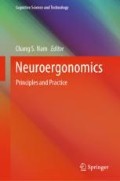Abstract
For neuroergonomists who wish to apply Adaptive Control of Thought-Rational (ACT-R) to investigate the human mind and its structure including learning, performance, and problem-solving skills, this chapter aims at providing an overview of ACT-R with an emphasis on its modules, buffers, and sub-symbolic levels. ACT-R is a high-level computational simulation of human cognitive processing and one of the cognition theories that seek to predict human performance in real-world settings. A group of previous studies on behavioral- and neural-based cognitive modeling of human cognition using ACT-R will also be discussed. Finally, this chapter presents future directions of ACT-R for neuroergonomics research.
Access this chapter
Tax calculation will be finalised at checkout
Purchases are for personal use only
References
Anderson, J. R. (1983). Cognitive science series. The architecture of cognition. Hillsdale, NJ, US.
Anderson, J. R. (2007). How can the human mind occur in the physical universe? Oxford University Press.
Anderson, J. R., Bothell, D., Byrne, M. D., Douglass, S., Lebiere, C., & Qin, Y. (2004). An integrated theory of the mind, 111(4), 1036–1060. https://doi.org/10.1037/0033-295X.111.4.1036.
Anderson, J. R., Carter, C. S., Fincham, J. M., Qin, Y., Ravizza, S. M., & Rosenberg-lee, M. (2008). Using fMRI to test models of complex cognition. Cog, 32(8), 1323–1348. https://doi.org/10.1080/03640210802451588.
Anderson, J. R., Qin, Y., Jung, K. J., & Carter, C. S. (2007). Information-processing modules and their relative modality specificity. Cognitive psychology, 54(3), 185–217.
Cassenti, D. N., Kerick, S. E., & McDowell, K. (2011). Observing and modeling cognitive events through event-related potentials and ACT-R. Cognitive Systems Research, 12(1), 56–65. https://doi.org/10.1016/j.cogsys.2010.01.002.
Gray, W. D., Schoelles, M. J., & Sims, C. R. (2005). Adapting to the task environment : Explorations in expected value. Action editor : Christian Schunn, 6, 27–40. https://doi.org/10.1016/j.cogsys.2004.09.004.
Kim, N., Kim, W., Yun, M. H., & Nam, C. S. (2018). Behavioral and neural correlates of hysteresis effects during multitasking, 2010–2012. https://doi.org/10.1177/1541931218621003.
Laird, J. E. (2012). The SOAR cognitive architecture. MIT press.
Langley, P., Laird, J. E., & Rogers, S. (2009). Cognitive architectures: Research issues and challenges. Coginitive Systems Research, 10(2), 141–160. https://doi.org/10.1016/j.cogsys.2006.07.004.
Lebiere, C., & Anderson, R. A. (1993). A connectionist implementation of the ACT-R production system. In The Fifteenth Annual Conference of the Cognitive Science Society (pp. 635–640).
Lebiere, C., Anderson, J. R., & Bothell, D. (2002). Multi-tasking and cognitive workload in an ACT-R model of a simplified air traffic control task. Paper presented at the 10th Conference on Computer Generated Forces and Behavioral Representation, Norfolk, VA.
Lebiere, C., Anderson, J. R., Bothell, D., Lebiere, C., & Anderson, J. R. (2001). Multi-tasking and cognitive workload in an ACT- R model of a simplified air traffic control task.
Matessa, M. (2008). An ACT-R representation of information processing in autism ACT-R. In Proceedings of the Thirtieth Annual Conference of the Cognitive Science Society (pp. 2168–2173).
McKendrick, R., & Parasuraman, R. (2014). Using functional near infrared spectroscopy (fNIRS) to evaluate the neurocognitive effects of transient events: Design matrix mixed effects analysis. In Proceedings of the Human Factors and Ergonomics Society Annual Meeting (pp. 235–239). Los Angeles, CA: Sage Publications.
Nijboer, M., Borst, J., Van Rijn, H., & Taatgen, N. (2016). Contrasting single and multi-component working-memory systems in dual tasking. Cognitive Psychology, 86, 1–26. https://doi.org/10.1016/j.cogpsych.2016.01.003.
Parasuraman, R., Christensen, J., & Grafton, S. (2012). Neuroergonomics: The brain in action and at work. Neuroimage, 59(1), 1.
Ratcliff, R. (1978). A theory of memory retrieval. Psychological Review, 85(2), 59.
Salvucci, D. D., Kushleyeva, Y., & Lee, F. J. (2004). Toward an ACT-R general executive for human multitasking. In ICCM (pp. 267–272).
Smart, P. R., Scutt, T., Sycara, K., & Shadbolt, N. R. (2016). Integrating ACT-R cognitive models with the unity game engine (pp. 74–86).
Sun, R. (2006). The CLARION cognitive architecture: Extending cognitive modeling to social simulation. In Cognition and Multi-Agent Interaction (pp. 79–99).
Sun, R. (2007). Cognitive social simulation incorporating cognitive architectures. IEEE Intelligent Systems, 22(5).
Taatgen, N., & Anderson, R. (2010). The past, present, and future of cognitive architectures. Topics in Cognitive Science, 2(4), 693–704. https://doi.org/10.1111/j.1756-8765.2009.01063.x.
Taatgen, N., Lebiere, C., & Anderson, J. (2006). Modeling paradigms in ACT-R. In Cognition and Multi-agent Interaction: From Cognitive Modeling to Social Simulation (pp. 29–52).
Taatgen, N. A., & Lee, F. J. (2003). Production compilation: A simple mechanism to model complex skill acquisition. Human Factors, 45(1), 61–76.
Usher, M., & McClelland, J. L. (2001). The time course of perceptual choice: The leaky, competing accumulator model. Psychological Review, 108(3), 550.
van Maanen, L., & Hedderik van Rijn, N. T. (2012). RACE/A: An architectural account of the interactions between learning, task control, and retrieval dynamics. Cognitive Science, 36, 62–101. https://doi.org/10.1111/j.1551-6709.2011.01213.x.
Van Vugt, M. K. (2014). NeuroImage cognitive architectures as a tool for investigating the role of oscillatory power and coherence in cognition. NeuroImage, 85, 685–693. https://doi.org/10.1016/j.neuroimage.2013.09.076.
Van Vugt, M. K. & Groningen, A. G. (2012). Relating ACT-R buffer activation to EEG activity during an attentional blink task. In N. Rußwinkel, U. Drewitz, & H. van Rijn (Eds.), (p. 218).
Whitehill, J. (2013). Understanding ACT-R—An outsider’s perspective. arXiv [Preprint]. arXiv:1306.0125.
Wilson, G. F., & Russell, C. A. (2007). Performance enhancement in an uninhabited air vehicle task using psychophysiologically determined adaptive aiding. Human Factors, 49(6), 1005–1018.
Author information
Authors and Affiliations
Corresponding author
Editor information
Editors and Affiliations
Rights and permissions
Copyright information
© 2020 Springer Nature Switzerland AG
About this chapter
Cite this chapter
Kim, N., Nam, C.S. (2020). Adaptive Control of Thought-Rational (ACT-R): Applying a Cognitive Architecture to Neuroergonomics. In: Nam, C. (eds) Neuroergonomics. Cognitive Science and Technology. Springer, Cham. https://doi.org/10.1007/978-3-030-34784-0_6
Download citation
DOI: https://doi.org/10.1007/978-3-030-34784-0_6
Published:
Publisher Name: Springer, Cham
Print ISBN: 978-3-030-34783-3
Online ISBN: 978-3-030-34784-0
eBook Packages: Intelligent Technologies and RoboticsIntelligent Technologies and Robotics (R0)

